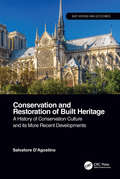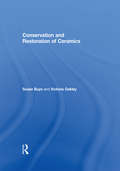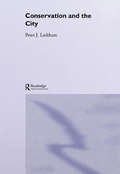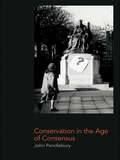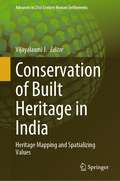- Table View
- List View
Conservation and Restoration of Built Heritage: A History of Conservation Culture and its More Recent Developments (Built Heritage and Geotechnics)
by Salvatore D'AgostinoThe word conservation, when used in the context of the preservation of built heritage, implies an intrinsically complex concept that evolved over time, since it has been influenced by the perception of history throughout time. This volume emphasises why an understanding of the cultural evolution of the conservation approach must be considered a prerequisite for architects and engineers if they are to cooperate in full harmony with historic-artistic culture for the preservation of global built heritage. In particular, the volume highlights how, during the second half of the last century, the preservation process also involved engineering – the science of making practical applications of knowledge – which, for a long time, made an uncritical use of techniques and materials and devised interventions on historical heritage that were heavily invasive. The volume also devotes special attention to the problems related to seismic risk, to which Italy, Greece and Portugal are particularly prone. Problems that emerge during the crisis and reconstruction phases are dealt with in detail, as is scheduled maintenance, as this latter approach always constitutes an improvement in the performance of the monument and is the most appropriate tool for the conservation of the built heritage. Finally, the volume collects examples of building restoration with case studies of many outstanding monuments. The work will appeal to professionals and academics in the broader fields of civil engineering (both geotechnical and structural engineering), architecture, art history, the history of architecture, restoration and cultural heritage management. This book will: Provide a critical reading of the history of conservation; Discuss materials and techniques of ancient architecture; Cover seismic vulnerability and preservation of the historic integrity of the monument; Advocate an approach based on programmed maintenance; Feature numerous case histories, including St Mark’s Basilica in Venice and the complex restoration of the cathedral of Notre-Dame in Paris.
Conservation and Restoration of Ceramics (Butterworth-heinemann Series In Conservation And Museology Ser.)
by Susan Buys Victoria OakleyThe Conservation and Restoration of Ceramics brings together the wide range of current information relevant to the practising conservator. The book opens with a discussion of the fundamental nature of the ceramic medium, information which is of primary importance when selecting treatments or considering preventive conservation measures. Details on techniques are given in a series of chapters covering the restoration and conservation processes, but the emphasis is on the basic principles involved in the choice of materials and methods. The nature and properties of materials commonly in use are fully discussed and guidance is given on the facilities and equipment needed.Also covered in the book are old restoration materials and methods, the ethics of ceramics conservation, examination and recording, display treatments and emergency procedures.Now in paperback, this book will be invaluable to practising conservators and readers of conservation as well as of interest to museum curators and collectors.
Conservation and Restoration of Ceramics
by Susan Buys Victoria OakleyThe Conservation and Restoration of Ceramics brings together the wide range of current information relevant to the practising conservator. The book opens with a discussion of the fundamental nature of the ceramic medium, information which is of primary importance when selecting treatments or considering preventive conservation measures. Details on techniques are given in a series of chapters covering the restoration and conservation processes, but the emphasis is on the basic principles involved in the choice of materials and methods. The nature and properties of materials commonly in use are fully discussed and guidance is given on the facilities and equipment needed.Also covered in the book are old restoration materials and methods, the ethics of ceramics conservation, examination and recording, display treatments and emergency procedures.Now in paperback, this book will be invaluable to practising conservators and readers of conservation as well as of interest to museum curators and collectors.
Conservation and Restoration of Glass
by Sandra Davison R.G. NewtonConservation and Restoration of Glass is an in-depth guide to the materials and practices required for the care and preservation of glass objects. It provides thorough coverage of both theoretical and practical aspects of glass conservation.This new edition of Newton and Davison's original book, Conservation of Glass, includes sections on the nature of glass, the historical development and technology of glassmaking, and the deterioration of glass. Professional conservators will welcome the inclusion of recommendations for examination and documentation. Incorporating treatment of both excavated glass and historic and decorative glass, the book provides the knowledge required by conservators and restorers and is invaluable for anyone with glass objects in their care.
Conservation and Restoration of Glass (Butterworth-heinemann Series In Conservation And Museology)
by Sandra Davison R.G. NewtonConservation and Restoration of Glass is an in-depth guide to the materials and practices required for the care and preservation of glass objects. It provides thorough coverage of both theoretical and practical aspects of glass conservation.This new edition of Newton and Davison's original book, Conservation of Glass, includes sections on the nature of glass, the historical development and technology of glassmaking, and the deterioration of glass. Professional conservators will welcome the inclusion of recommendations for examination and documentation. Incorporating treatment of both excavated glass and historic and decorative glass, the book provides the knowledge required by conservators and restorers and is invaluable for anyone with glass objects in their care.
Conservation and the City
by Peter LarkhamIt is a widely held belief that cities must change, or they will wither and die. One of the key problems of urbanization is how to cope with these changes while retaining the structures constructed and maintained by previous generations. Conservation and the City is a study of conservation and change throughout the built environment - city centres, suburbs and even tiny villages - and how the activites of conservation interact with the planning system. Using detailed case studies from Britain and the Westernized world, the author examines some of the key social, economic and psychological ideas which support conservation, as well as studying the urban landscape and the agents of change. Conservation and the City seeks to understand urban conservation, and in doing so presents possible solutions for managing change in the built environment of the future.
Conservation and the City
by Peter LarkhamIt is a widely held belief that cities must change, or they will wither and die. One of the key problems of urbanization is how to cope with these changes while retaining the structures constructed and maintained by previous generations. Conservation and the City is a study of conservation and change throughout the built environment - city centres, suburbs and even tiny villages - and how the activites of conservation interact with the planning system. Using detailed case studies from Britain and the Westernized world, the author examines some of the key social, economic and psychological ideas which support conservation, as well as studying the urban landscape and the agents of change. Conservation and the City seeks to understand urban conservation, and in doing so presents possible solutions for managing change in the built environment of the future.
Conservation in the Age of Consensus
by John PendleburyThis new text on the subject of conservation in the built environment provides a unique holistic view on the understanding of the practice of conservation connecting it with wider societal and political forces. UK practice is used as a means, along with international examples, for bringing together a real understanding of practice with a social science analysis of the issues. The author introduces ideas about the meanings and values attached to historic environments and how that translates into public policies of conservation.
Conservation in the Age of Consensus
by John PendleburyThis new text on the subject of conservation in the built environment provides a unique holistic view on the understanding of the practice of conservation connecting it with wider societal and political forces. UK practice is used as a means, along with international examples, for bringing together a real understanding of practice with a social science analysis of the issues. The author introduces ideas about the meanings and values attached to historic environments and how that translates into public policies of conservation.
The Conservation Movement: Antiquity to Modernity
by Miles GlendinningWinner of the 2016 Antoinette Forrester Downing Award presented by the Society of Architectural Historians. In many cities across the world, particularly in Europe, old buildings form a prominent part of the built environment, and we often take it for granted that their contribution is intrinsically positive. How has that widely-shared belief come about, and is its continued general acceptance inevitable? Certainly, ancient structures have long been treated with care and reverence in many societies, including classical Rome and Greece. But only in modern Europe and America, in the last two centuries, has this care been elaborated and energised into a forceful, dynamic ideology: a ‘Conservation Movement’, infused with a sense of historical destiny and loss, that paradoxically shared many of the characteristics of Enlightenment modernity. The close inter-relationship between conservation and modern civilisation was most dramatically heightened in periods of war or social upheaval, beginning with the French Revolution, and rising to a tragic climax in the 20th-century age of totalitarian extremism; more recently the troubled relationship of ‘heritage’ and global commercialism has become dominant. Miles Glendinning’s new book authoritatively presents, for the first time, the entire history of this architectural Conservation Movement, and traces its dramatic fluctuations in ideas and popularity, ending by questioning whether its recent international ascendancy can last indefinitely.
The Conservation Movement: Antiquity to Modernity
by Miles GlendinningWinner of the 2016 Antoinette Forrester Downing Award presented by the Society of Architectural Historians. In many cities across the world, particularly in Europe, old buildings form a prominent part of the built environment, and we often take it for granted that their contribution is intrinsically positive. How has that widely-shared belief come about, and is its continued general acceptance inevitable? Certainly, ancient structures have long been treated with care and reverence in many societies, including classical Rome and Greece. But only in modern Europe and America, in the last two centuries, has this care been elaborated and energised into a forceful, dynamic ideology: a ‘Conservation Movement’, infused with a sense of historical destiny and loss, that paradoxically shared many of the characteristics of Enlightenment modernity. The close inter-relationship between conservation and modern civilisation was most dramatically heightened in periods of war or social upheaval, beginning with the French Revolution, and rising to a tragic climax in the 20th-century age of totalitarian extremism; more recently the troubled relationship of ‘heritage’ and global commercialism has become dominant. Miles Glendinning’s new book authoritatively presents, for the first time, the entire history of this architectural Conservation Movement, and traces its dramatic fluctuations in ideas and popularity, ending by questioning whether its recent international ascendancy can last indefinitely.
Conservation of Architectural Heritage: Developing Sustainable Practices (Advances in Science, Technology & Innovation)
by Maria Luisa Germanà Natsuko Akagawa Antonella Versaci Nicola CavalagliThis book presents practical, applicable solutions that contribute to built heritage conservation, discussing challenges like resource constraints, ineffective legislation, lack of coordination between different relevant bodies, and absence of public awareness and involvement. This is to maintain the beauty and cultural meaning of the architectural heritage since they are like a glimpse from the past life, representing how people lived, their religions, and beliefs in addition to the primitive but inspirational technology used in construction. As a result, this book is of significant importance to professionals in the fields of architecture, sustainability, as well as policymakers.
Conservation of Architectural Ironwork
by David S. MitchellThe peak of architectural ironwork in the 19th Century saw the spread of ornate decorative ironwork across the world. In recent years there has been a significant increase in conservation and restoration projects aiming to protect the artistry of traditional ironwork for future generations. Conservation of Architectural Ironwork is the first book to provide a complete guide to the conservation and maintenance of traditional architectural ironwork. First introducing the contextual history and key material features of architectural ironwork, the book goes on to guide readers through the management and delivery of conservation projects from start to finish, explaining the very latest in conservation technology. At its peak, architectural ironwork was used on a vast global scale in buildings, bridges, street furniture and ornamental structures. With international case studies and detailed illustrations, this book will be an essential reference for heritage professionals and students of architectural conservation around the world.
Conservation of Architectural Ironwork
by David S. MitchellThe peak of architectural ironwork in the 19th Century saw the spread of ornate decorative ironwork across the world. In recent years there has been a significant increase in conservation and restoration projects aiming to protect the artistry of traditional ironwork for future generations. Conservation of Architectural Ironwork is the first book to provide a complete guide to the conservation and maintenance of traditional architectural ironwork. First introducing the contextual history and key material features of architectural ironwork, the book goes on to guide readers through the management and delivery of conservation projects from start to finish, explaining the very latest in conservation technology. At its peak, architectural ironwork was used on a vast global scale in buildings, bridges, street furniture and ornamental structures. With international case studies and detailed illustrations, this book will be an essential reference for heritage professionals and students of architectural conservation around the world.
Conservation of Books (Routledge Series in Conservation and Museology)
by Abigail BainbridgeConservation of Books is the highly anticipated reference work on global book structures and their conservation, offering the first modern, comprehensive overview on this subject. The volume takes an international approach to its subject. Written by over 70 specialists in conservation and conservation science based in 19 countries, its 26 chapters cover traditional book structures from around the world, the materials from which they are made and how they degrade, and how to preserve and conserve them. It also examines the theoretical underpinnings of conservation: what and how to treat, and the ethical, cultural, and economic implications of treatment. Technical drawings and photographs illustrate the structures and treatments examined throughout the book. Ultimately, readers gain an in-depth understanding of the materiality of books in numerous global contexts and reflect on the practical considerations involved in their analysis and treatment. Conservation of Books is a quintessential reference work for book conservators and anyone working with books, such as collection managers, librarians, curators, dealers, collectors, historians, and related professionals. It is also an indispensable text for students to complement hands-on training in this field.
Conservation of Books (Routledge Series in Conservation and Museology)
by Abigail BainbridgeConservation of Books is the highly anticipated reference work on global book structures and their conservation, offering the first modern, comprehensive overview on this subject. The volume takes an international approach to its subject. Written by over 70 specialists in conservation and conservation science based in 19 countries, its 26 chapters cover traditional book structures from around the world, the materials from which they are made and how they degrade, and how to preserve and conserve them. It also examines the theoretical underpinnings of conservation: what and how to treat, and the ethical, cultural, and economic implications of treatment. Technical drawings and photographs illustrate the structures and treatments examined throughout the book. Ultimately, readers gain an in-depth understanding of the materiality of books in numerous global contexts and reflect on the practical considerations involved in their analysis and treatment. Conservation of Books is a quintessential reference work for book conservators and anyone working with books, such as collection managers, librarians, curators, dealers, collectors, historians, and related professionals. It is also an indispensable text for students to complement hands-on training in this field.
Conservation of Building and Decorative Stone
by F G Dimes J. AshurstOne of the problems which beset the practical conservation of stone buildings is the fragmentation of the disciplines involved. This book, with both volumes now available as one invaluable paperback, brings these disciplines together by the involvement of contributors with different experiences and approaches to the same material. Part one is an introduction to the complexities and background history of stone conservation followed by the most comprehensive description yet produced of the building and decorative stones used in the British Isles.In part two, practitioners involved in stone conservation describe ways in which major structural masonry problems, secondary building problems and different stone surface conditions may be treated. A variety of building types and environments has been used to ensure that the broad scope of common problems is covered. This second part of the book will be of practical value to art historians, archaeologists, architects, surveyors and engineers, masonry contractors and sculpture conservators in solving problems and in learning to use each other's skills and experience.
Conservation of Building and Decorative Stone (Butterworth-heinemann Series In Conservation And Museology)
by F G Dimes J. AshurstOne of the problems which beset the practical conservation of stone buildings is the fragmentation of the disciplines involved. This book, with both volumes now available as one invaluable paperback, brings these disciplines together by the involvement of contributors with different experiences and approaches to the same material. Part one is an introduction to the complexities and background history of stone conservation followed by the most comprehensive description yet produced of the building and decorative stones used in the British Isles.In part two, practitioners involved in stone conservation describe ways in which major structural masonry problems, secondary building problems and different stone surface conditions may be treated. A variety of building types and environments has been used to ensure that the broad scope of common problems is covered. This second part of the book will be of practical value to art historians, archaeologists, architects, surveyors and engineers, masonry contractors and sculpture conservators in solving problems and in learning to use each other's skills and experience.
Conservation of Built Heritage in India: Heritage Mapping and Spatializing Values (Advances in 21st Century Human Settlements)
by Vijayalaxmi J.This book focuses on the Heritage Conservation of Architecture, Historic Districts of a City and Conservation strategies with specific case studies from India, in order to highlight the need for conserving the rich piece of history through research, education, advocacy, and practice. The historic significance and the condition mapping of the subjects are carried out through primary field studies by the authors at School of Planning and Architecture, Vijayawada, India. The cases are analysed, and appropriate solutions and sustainable strategies are evolved for the conservation of the buildings facing contemporary challenges. The contents align with the Sustainable Development Goals (SDG 11), Target 11.4 which aims to “strengthen efforts to protect and safeguard the world's cultural and natural heritage'. This would ensure that a rich piece of history is documented and analysed to ensure that it is not erased and forgotten. This book serves as a bountiful data base of literature as well as conservation strategies for heritage conservationists, students of architectural conservation and researchers.
Conservation of Easel Paintings (Routledge Series in Conservation and Museology)
by Joyce Hill Stoner Rebecca RushfieldConservation of Easel Paintings is the first comprehensive text on the history, philosophy, and methods of treatment of easel paintings that combines both theory with practice. With contributions from an international group of experts and interviews with important artists, this volume provides an all-encompassing guide to necessary background knowledge in technical art history, artists' materials, scientific methods of examination and documentation, with sections that present varying approaches and methods for treatment, including consolidation, lining, cleaning, retouching, and varnishing. The book concludes with a section featuring issues of preventive conservation, storage, shipping, exhibition, lighting, safety issues, and public outreach. Conservation of Easel Paintings is a crucial resource in the training of conservation students and will provide generations of practicing paintings conservators and interested art historians, curators, directors, collectors, dealers, artists, and students of art and art history with invaluable information and guidance.
Conservation of Easel Paintings (Routledge Series in Conservation and Museology)
by Joyce Hill Stoner Rebecca RushfieldConservation of Easel Paintings is the first comprehensive text on the history, philosophy, and methods of treatment of easel paintings that combines both theory with practice. With contributions from an international group of experts and interviews with important artists, this volume provides an all-encompassing guide to necessary background knowledge in technical art history, artists' materials, scientific methods of examination and documentation, with sections that present varying approaches and methods for treatment, including consolidation, lining, cleaning, retouching, and varnishing. The book concludes with a section featuring issues of preventive conservation, storage, shipping, exhibition, lighting, safety issues, and public outreach. Conservation of Easel Paintings is a crucial resource in the training of conservation students and will provide generations of practicing paintings conservators and interested art historians, curators, directors, collectors, dealers, artists, and students of art and art history with invaluable information and guidance.
Conservation of Furniture (Routledge Series In Conservation And Museology Ser.)
by Shayne Rivers Nick UmneyThis book is a comprehensive resource covering the principles and practice of the conservation and restoration of furniture, and other decorative art objects made wholly or partly of wood. It integrates theory with practice to show the principles which govern interaction between wooden objects, the environmental and conservation treatments and the factors which need to be taken into account to arrive at acceptable solutions to conservation problems.The practical knowledge and experience of a team of conservators active in the field are bought together with theoretical and reference material from diverse sources and unified within a systematic framework. Specialist conservators from related disciplines cover diverse materials often incorporated into furniture.
Conservation of Furniture
by Shayne Rivers Nick UmneyThis book is a comprehensive resource covering the principles and practice of the conservation and restoration of furniture, and other decorative art objects made wholly or partly of wood. It integrates theory with practice to show the principles which govern interaction between wooden objects, the environmental and conservation treatments and the factors which need to be taken into account to arrive at acceptable solutions to conservation problems.The practical knowledge and experience of a team of conservators active in the field are bought together with theoretical and reference material from diverse sources and unified within a systematic framework. Specialist conservators from related disciplines cover diverse materials often incorporated into furniture.
Conservation of Historic Buildings
by Bernard FeildenSince its publication in 1982 Sir Bernard Feilden's Conservation of Historic Buildings has become the standard text for architects and others involved in the conservation of historic structures. Leading practitioners around the world have praised the book as being the most significant single volume on the subject to be published. This third edition revises and updates a classic book, including completely new sections on conservation of Modern Movement buildings and non-destructive investigation. The result of the lifetime's experience of one of the world's leading architectural conservators, the book comprehensively surveys the fundamental principles of conservation in their application to historic buildings, and provides the basic information needed by architects, engineers and surveyors for the solution of problems of architectural conservation in almost every climatic region of the world. This edition is organized into three complementary parts: in the first the structure of buildings is dealt with in detail; the second focuses attention on the causes of decay and the materials they affect; and the third considers the practical role of the architect involved in conservation and rehabilitation. As well as being essential reading for architects and others concerned with conservation, many lay people with various kinds of responsibility for historic buildings will find this clearly written, jargon-free work a fruitful source of guidance and information.
Conservation of Historic Buildings
by Bernard FeildenSince its publication in 1982 Sir Bernard Feilden's Conservation of Historic Buildings has become the standard text for architects and others involved in the conservation of historic structures. Leading practitioners around the world have praised the book as being the most significant single volume on the subject to be published. This third edition revises and updates a classic book, including completely new sections on conservation of Modern Movement buildings and non-destructive investigation. The result of the lifetime's experience of one of the world's leading architectural conservators, the book comprehensively surveys the fundamental principles of conservation in their application to historic buildings, and provides the basic information needed by architects, engineers and surveyors for the solution of problems of architectural conservation in almost every climatic region of the world. This edition is organized into three complementary parts: in the first the structure of buildings is dealt with in detail; the second focuses attention on the causes of decay and the materials they affect; and the third considers the practical role of the architect involved in conservation and rehabilitation. As well as being essential reading for architects and others concerned with conservation, many lay people with various kinds of responsibility for historic buildings will find this clearly written, jargon-free work a fruitful source of guidance and information.
